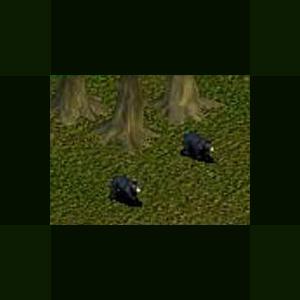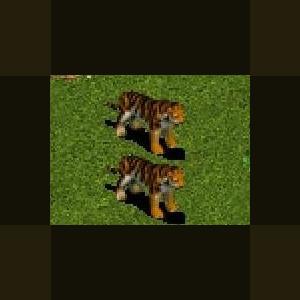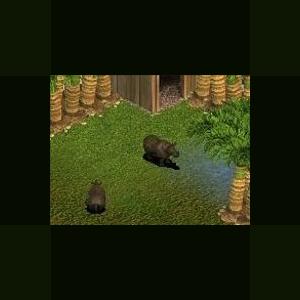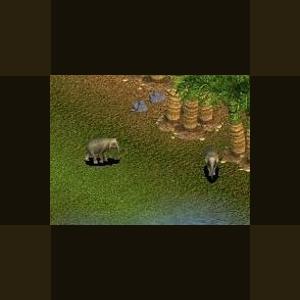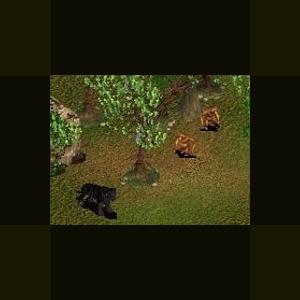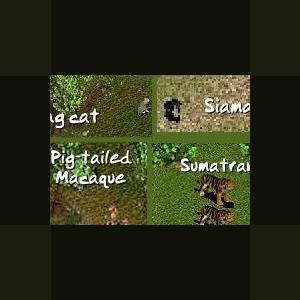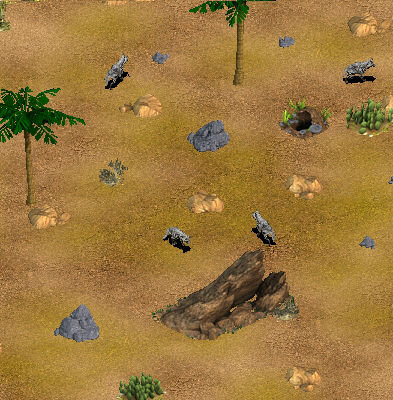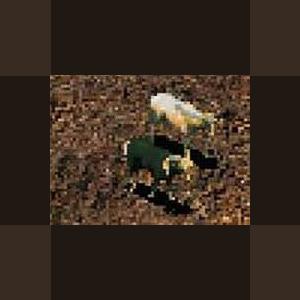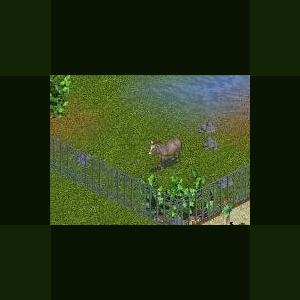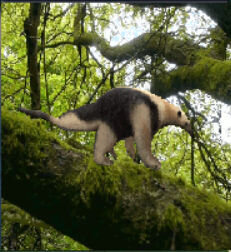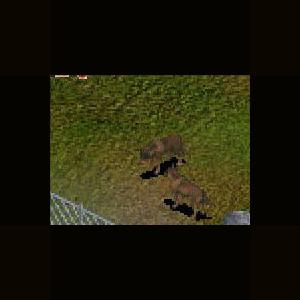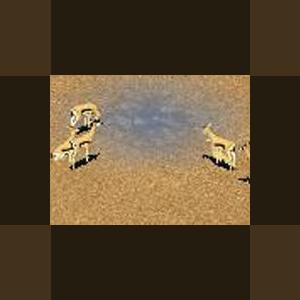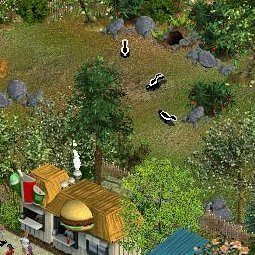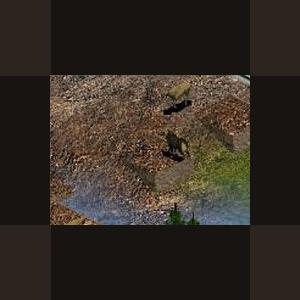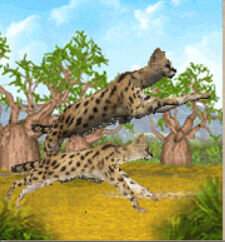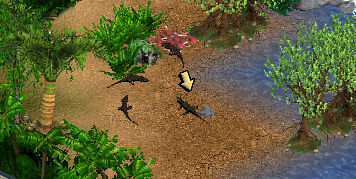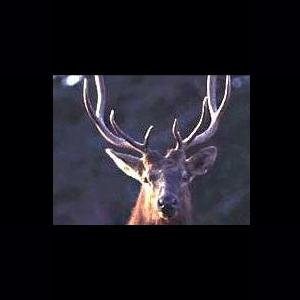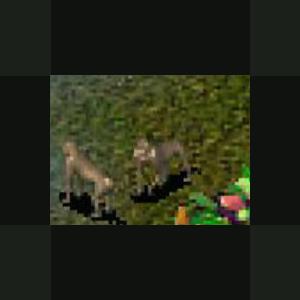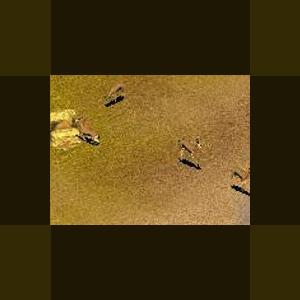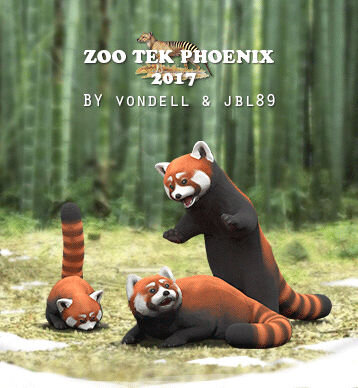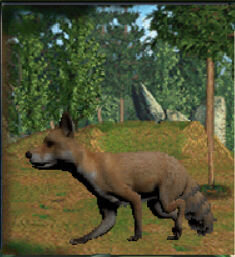279 files
-
Sun Bear by Ghirin
By Guest
Sun Bear
Author: Ghirin
The sun bear (Ursus malayanus, Helarctos malayanus) is the smallest species of living bear. It is native to the forests of Southeast Asia, including China, Thailand, Malaysia, Indonesia, and Vietnam. These bears are excellent climbers and spend the day sleeping and sunbathing in trees; they hunt at night.
Sun bears have black fur with a characteristic light-colored mark on the chest. The soles of their feet are free of fur to help in climbiing and they have large, curved claws for climbing, openning insect nests, and defense. These bears also use their long canine teeth to tear open trees to get at the insects hidden inside.
Sun bears eat a wide variety of foods, including insects, friut, honey, eggs, and small vertebrates.
They are solitary animals, with the only regular social group being that of mother and cubs.
Created by Ghirin 2003
Updated 2010-11-06
Just to save space with less in zip and smaller image.
Nothing new.
373 downloads
0 comments
Updated
-
Sun Bear by Khaydar
By Khaydar
Adopt a Sun Bear (Helarctos malayanus) for your zoos.
Sun Bear description:
Cannot be used in original Zoo Tycoon: Requires DD
Minimum happiness needed for chance of breeding: 95.
Liked foliage:
Rainforest Fern, Foxtail Palm Tree, Mangrove Tree, Durian Tree (ES)
Liked rock:
Large Rock, Small Rock - Medium, Small Rock - Small, Rainforest Rock
Stone Ruins
Animal can jump.
Animal can climb objects.
Animal can climb cliff.
Number of animals allowed per exhibit: 1-3 with 35 squares each.
A suitable exhibit for 2 of this animal has 70 squares containing terrain of:
42 Rainforest Floor, 14 Dirt, 14 Grass
using 14 grid squares filled with 4 Foxtail Palm Tree most liked plant
and using 20 Small Rock - Small most liked rock.
Of the 70 squares, 1 nonadjacent squares should be elevated.
Preferred shelter: Rock Cave.
Other liked items:
Orangutan Jungle Gym (ES), Orangutan Rope Swing (ES)
Credits to DutchDesigns for the model and mesh
Made by Khaydar
159 downloads
- living animal
- bear
- (and 1 more)
0 comments
Updated
-
Sumatran Tiger by LAwebTek
By Guest
Sumatran Tiger
Author: LAwebTek
The Sumatran tiger (Panthera tigris) is found only on the Indonesian island of Sumatra in habitat that ranges from lowland forest to sub mountain and mountain forest including some peat moss forests. According the the Tiger Information Center and the World Wildlife Fund there are no more than 500 of these tigers left in the wild with some estimates considerably lower.
Indonesia has well over 300 different kinds of plant life. To achieve a similar effect in the game, all of the following may be used in the Samatran tiger exhibit: Mossy rainforest rock, tall grass, Mangrove tree, Orcid tree, Elephant Ear tree, Rafflesia, Giant ficus tree, Foxtail palm, Williamsonia tree, rainforest stump, Fallen rainforest tree, Ulma tree, Leptocycas tree, Llala palm, Kapok tree, Fern bush, Thouarsus cyad, Bonsai, Snowbell tree, Japanese maple, Chinese fir, Dawn redwood, Norfolk island tree, Palm tree and Bamboo. The Samatran tiger can also swim in a marine tank if attached to its exhibit.
Updated 2010-11-06
Just to save space with less in zip and smaller image.
Nothing new.
333 downloads
0 comments
Updated
-
Sumatran Rhinoceros by Khaydar
By Khaydar
Adopt a Sumatran Rhinoceros (Dicerorhinus sumatrensis) for your zoos.
Sumatran Rhinoceros description:
Minimum happiness needed for chance of breeding: 90.
Liked foliage:
Rainforest Fern, Mangrove Tree, Foxtail Palm Tree
Liked rock:
Large Rock, Small Rock - Medium, Small Rock - Small
Animal can climb objects.
Number of animals allowed per exhibit: 1-2 with 50 squares each.
A suitable exhibit for 2 of this animal has 100 squares containing terrain of:
80 Rainforest Floor, 5 Dirt, 10 Grass, 5 Fresh Water
using 19 grid squares filled with 4 Foxtail Palm Tree most liked plant
and using 8 Small Rock - Small most liked rock.
Preferred shelter: Large Stable.
Other liked items:
Waterfall Rock,
Credits to Eryel for the model and mesh
Made by Khaydar
169 downloads
- living animal
- rhinoceros
- (and 1 more)
Updated
-
Sumatran Rhino by Jordan
By Guest
Also known as the "hairy rhino," the Sumatran rhinoceros is among the world's most endangered mammals..
In the past 10 years, almost 50 percent of these rhinos have been lost to poaching. Now less than 300 survive in isolated pockets in Southeast Asia. Besides being the only rhino with hair on its body, the Sumatran rhino is also the only two-horned species in Asia. It has rarely been seen because of the dense rainforest and moss forest where it lives. This rhino is considered a descendant of the prehistoric woolly rhinoceros, depicted in Stone Age cave drawings in Europe.
Updated 2010-11-06
Just to save space with less in zip and smaller image.
Nothing new.
500 downloads
0 comments
Updated
-
Sumatran Elephant by Jordan
By Guest
Sumatran elephants are the smallest of the Asian elephants. Males rarely develop long tusks, while those of adult females may be so short that they are hidden by the upper lip. This elephant can live up to 70 years in captivity, less in the wild.
The endangered Sumatran elephant (Elephas maximus sumatranus) is the smallest (and perhaps oldest) of the Asian subspecies and is unique to the island of Sumatra. It has been protected in Indonesia since 1931. Population surveys conducted in the 1980’s estimated that only 2800 – 4500 wild elephants remained. It is likely that even fewer survive in today’s fragmented forests. The term "pocket elephants" was originally coined to refer to their diminutive size, and also reflects their survival today in the few remaining "pockets" of lowland rainforest.
The combined effects of road development, logging, conversion of forest to agriculture, and human resettlement have contributed to the loss of thousands of hectares of elephant habitat. As habitat shrinks, elephants are forced into conflict with humans. The destruction of crops and houses results in injuries and deaths of both humans and elephants.
Villagers faced with raiding elephants demanded that the government resolve the problem. To these villagers, the elephants were just dangerous crop-raiding pests. Occasionally, angry villagers have poisoned elephants. Unlike other Asian countries, with strong elephant traditions, elephants are not revered in Indonesia.
The government of Indonesia began establishing Elephant Centers on Sumatra in 1986 in an attempt to relieve human-elephant conflicts. Today there are six Centers that hold approximately 400 elephants.
Updated 2010-11-06
Just to save space with less in zip and smaller image.
Nothing new.
366 downloads
0 comments
Updated
-
Sumatran Cryptids by Jordan
By Guest
Sumatran Cryptids by Jordan
The Orang Pendek and Cigau cryptids of Sumatra, combined into one ztd.
Cigau
The Cigau is a Sumatran mystery wild cat described as a cross between a lion and a tiger. Described as being slightly smaller, but apparently more heavily built, than the Sumatran tiger, they are greatly feared by the hunters of Kerinci--the only animal to produce such a reaction. They claimed the cigau attacks without provocation. "Cigau hates man".
Animal recolor and programming by Jordan, stat change and research by Genkicoll.
Orang Pendek
The orang pendek is an orangutan-like cryptid from the island of Sumatra.
The orang pendek is fully compatible with the orangutan for those inclined to making mixed exhibits.um
Updated 2010-11-06
Just to save space with less in zip and smaller image.
Nothing new.
212 downloads
0 comments
Updated
-
Sumatran Animals by Tek Design
By Guest
Four Sumatran animals:
Fishing cat, Siamang, Pigtailed Macaque, and Sumatran Tiger
Updated 2010-11-06
Just to save space with less in zip and smaller image.
Nothing new.
390 downloads
0 comments
Updated
-
Striped Hyena by Khaydar
By Khaydar
A striped Hyena for your zoos. It lives in an arid environment and likes caves/burrows.
216 downloads
Updated
-
Stones Sheep by Ghirin
By Guest
Stones Sheep
Author: Ghirin
http://www.zoo-tek.com/forums/index.php?download=153
Stone’s sheep (Ovis dalli stonei) is one of the two subspecies of North American thinhorn sheep; the other subspecies is Dall’s sheep (Ovis dalli dalli). The major distinction between Stone’s sheep and Dall’s sheep is color: Stone’s sheep may be grey, brown, or black while Dall’s sheep is well known for its white fur. In both subspecies, the horns of the ram are less massive than those of the bighorn sheep, thus the name thinhorn.
Although Stone's sheep are well-adapted to a range of elevations and temperatures, they prefer steep, rocky regions and are attracted by open alpine meadows containing a variety of grasses and succulent, low-growing vegetation. In captivity, the natural diet of these sheep is supplemented with alfalfa and grain pellets. In the wild, these animals will eagerly seek out mineral licks containing salt.
Gregarious animals, Stone's sheep sometimes gather in herds of over 100 individuals. In the wild, herds consist of a dominant ewe and a mixture of ewes, yearlings, and lambs. Rams travel in small bands of their own, joining the females during the mating season.
Stone's sheep are very alert and, in addition to possessing keen hearing and a good sense of smell, have remarkable vision that allows them to judge distances accurately when jumping and locating footholds. They can spot other animals moving from up to a mile away. Stone's sheep hooves are hard on the outside and soft on the inside, and so act as shock absorbers, contributing to the sheep's ability to rapidly scramble up rocky terrain.
Stone’s sheep is less abundant than Dall’s sheep and has a smaller distribution, ranging from the British Columbian/Yukon border into the central Yukon.
Created by Ghirin 2003
Updated 2010-11-06
Just to save space with less in zip and smaller image.
Nothing new.
279 downloads
0 comments
Updated
-
Spectacled Bear by Khaydar
By Khaydar
Adopt a Spectacled Bear (Tremarctos ornatus) for your zoos.
Spectacled Bear description:
Minimum happiness needed for chance of breeding: 95.
Liked foliage:
Western Juniper Tree, Paper Birch Tree
Liked rock:
Large Rock, Small Rock - Medium, Small Rock - Small, Rock Formation
Animal can jump.
Animal can climb objects.
Animal can climb cliff.
Number of animals allowed per exhibit: 1-3 with 35 squares each.
A suitable exhibit for 2 of this animal has 70 squares containing terrain of:
41 Gray Stone, 7 Dirt, 11 Grass, 7 Snow, 4 Fresh Water
using 7 grid squares filled with 4 Paper Birch Tree most liked plant
and using 20 Small Rock - Small most liked rock.
Of the 70 squares, 8 nonadjacent squares should be elevated.
Preferred shelter: Rock Cave.
Other liked items:
Highland Rock
Credits to Aurora Designs for the model and mesh
Made by Khaydar
162 downloads
- living animal
- bear
- (and 1 more)
0 comments
Updated
-
Spanish Mustang by Sundance
By Guest
Spanish Mustang by Sundance
A beautiful Spanish Mustang
The true Spanish Mustang is a direct descendant of the horses brought to the New World by the early Spaniards. Confused by many with the feral horses currently managed by the Bureau of Land Management (B.L.M.), there is a vast difference in both appearance and ancestry. Columbus, on order from the Spanish throne, commenced bringing the first Spanish horses to the New World on his second voyage. Thereafter, each ship headed for the New World, by order of the Crown, carried breeding animals of choice Spanish stock. Breeding farms were set up in the Caribbean and subsequently in Mexico. Breeding farms such as the one operated in Sonora, Mexico by Padre Eusebio Kino, a Jesuit priest, produced stock, including horses, which were placed with each group of Christianized Indians as Kino expanded his efforts further and further north. The Apaches, never falling under the spell of the Church, ravaged and pillaged these little "visitas" taking stock at will. They also plundered deep into Mexico allegedly as far as Mexico City. Their goal - well-bred and trained Spanish horses from the Mexican estancias. Through trade of these valuable horses northward to other tribes the Apaches became one of the primary methods of spreading the Spanish horses over the west. Over the years horses escaped, were lost or stolen and many became feral, roaming all over the west. Eventually they numbered in the hundreds of thousands, closely related to the horses maintained by some of the Indian tribes; indeed, they were basically the same horses
Updated 2010-11-06
Just to save space with less in zip and smaller image.
Nothing new.
241 downloads
0 comments
Updated
-
Southern Anteater by Khaydar
By Khaydar
Adopt a Southern Anteater (Tamandua tetradactyla) for your zoos.
Southern Anteater description:
Cannot be used in original Zoo Tycoon: Requires DD
Minimum happiness needed for chance of breeding: 95.
Liked foliage:
Ulmo Tree, Llala Palm Tree, Kapok Tree
Animal can climb objects.
Animal can climb cliff.
Number of animals allowed per exhibit: 1-3 with 15 squares each.
A suitable exhibit for 2 of this animal has 30 squares containing terrain of:
24 Rainforest Floor, 2 Grass, 3 Dirt, 1 Fresh Water
using 4 grid squares filled with 4 Ulmo Tree most liked plant
and using no rocks.
Preferred shelter: Large Burrow.
Credits to Hendrix and Zerosvalmont for the model and mesh
Made by Khaydar
217 downloads
- living animal
- anteater
- (and 1 more)
Updated
-
Small-eared Dog by BigCatKeeper
By Guest
Small-eared Dog
Author: BigCatKeeper
Also known as the Small-Eared Fox, Small-Eared Zorro, Short-Eared Fox, and Dusicyon Microtis.
They have a thick, stocky body set on relatively short narrow legs. Their muzzle is very long and thin, with short, rounded ears set to the sides of the head. They range from dark reddish-grey to black on their backs, blending to a rufous color underneath. Their undersides have pale-colored parts. Their bushy tail has very thick, black hair.
Their paws are partially webbed, suggesting that they may be somewhat aquatic.
Average height is 10 in. (25 cm), weighing 22 lb (10 kg).
Small-Eared Dog can be either nocturnal or diurnal, and natives report that they are solitary. For the most part, they seem to be docile and non-aggressive towards humans. Males seem to have a musky odour that females do not.
The most urgent threat to this dog is habitat loss, since they only thrive in areas undisturbed by humans. Jaguars, ocelots and cougars are all potential predators of this much smaller fox.
Small Eared Dog created by Bigcatkeeper
Updated 2010-11-06
Just to save space with less in zip and smaller image.
Nothing new.
251 downloads
0 comments
Updated
-
Sloth Bear by Khaydar
By Khaydar
Adopt a Sloth Bear (Melursus ursinus) for your zoos.
Sloth Bear description:
Cannot be used in original Zoo Tycoon: Requires DD
Minimum happiness needed for chance of breeding: 95.
Liked foliage:
Rainforest Fern, Mangrove Tree, Foxtail Palm Tree
Liked rock:
Large Rock, Small Rock - Medium, Small Rock - Small
Animal can jump.
Animal can climb objects.
Animal can climb cliff.
Number of animals allowed per exhibit: 1-3 with 35 squares each.
A suitable exhibit for 2 of this animal has 70 squares containing terrain of:
42 Rainforest Floor, 14 Dirt, 14 Grass
using 14 grid squares filled with 4 Foxtail Palm Tree most liked plant
and using 20 Small Rock - Small most liked rock.
Of the 70 squares, 1 nonadjacent squares should be elevated.
Preferred shelter: Rock Cave.
Other liked items:
Waterfall Rock, Cat Climbing Tree
Credits to DutchDesigns for the model and mesh
Made by Khaydar
176 downloads
- khaydars animal
- bear
- (and 1 more)
0 comments
Updated
-
Slender-horned Gazelle by Ghirin
By Guest
The slender-horned gazelle can survive in both stony and sandy desert. Its hooves are broadened for ease of travel over sand and it can obtain all of its water from the plants it eats, but will drink if water is available. Other adaptations for desert survival include the pale pelage and a special structure in the nose for cooling blood.
To avoid the heat of the day, slender-horned gazelles feed during the night and early morning. They range widely in search of food, usually traveling in herds of 3 to 10 animals.
References:
http://www.animalinfo.org/species/artiperi/gazelept.htm
http://www.livingdesert.org/sgslenderhornedgazelle.html
http://www.ultimateungulate.com/Artiodacty...leptoceros.html
Photograph:
http://www.mindspring.com/~zoonet/galleries/gazelle.htm
Updated 2010-11-06
Just to save space with less in zip and smaller image.
Nothing new.
298 downloads
0 comments
Updated
-
Skunk by msc3323
By Fern
Skunk by msc3323
Allowedly the Striped Skunk is not one of my best animals, but it can walk and stand. Here it is for your zoo-building pleasure :D
201 downloads
Updated
-
Siberian Snow Sheep by Ghirin
By Guest
Siberian Snow Sheep
Author: Ghirin
The snow sheep of northern Siberia are closely related to the thinhorn and bighorn sheep of North America, more so than they are related to the argali or urial of the central Asian highlands. These sheep are divided into several subspecies which inhabit various mountain ranges in northeastern Siberia. They graze in the alpine meadows and retreat to the rocky highlands when threatened.
Created by Ghirin 2003
Updated 2010-11-06
Just to save space with less in zip and smaller image.
Nothing new.
299 downloads
0 comments
Updated
-
Serval
By Khaydar
Adopt a Serval ( Leptailurus serval) for your zoos.
Animal guide:
Minimum happiness needed for chance of breeding: 97.
Liked foliage:
Savannah foliage
Liked rock:
Large Rock, Small Rock - Medium, Small Rock - Small
Animal can jump.
Animal can climb cliff.
Number of animals allowed per exhibit:
1-2 with 18 squares each.
A suitable exhibit for 2 of this animal has 36 squares containing terrain of:
26 Savannah Grass, 4 Sand, 4 Dirt, 2 Fresh Water
using 6 grid squares filled with 4 Tall Grass most liked plant
and using 19 Small Rock - Small most liked rock.
Preferred shelter:
Large Burrow.
Other liked items:
Waterfall Rock
381 downloads
- living animal
- khaydars animal
- (and 1 more)
Updated
-
Rough Neck Monitor by Khaydar
By Khaydar
Thanks for downloading the rough neck monitor lizard. Lives on mangroves alone or in small groups
237 downloads
Updated
-
Roosevelt Elk by Jordan
By Guest
Roosevelt Elk (Wapiti)
Scientific Name:
Cervus elaphus roosevelti
Size:
Height. at shoulder 4½-5'
Length. 8-10'
Weight. males 600-1000 lbs. | females 350-650 lbs.
Characteristics:
Adaptations/Coloration. brown or tan above | darker underparts | rump patch & tail yellowish brown | males dark brown mane on throat
Antlers. males large, many-tined antlers up to 5' | females lack antlers
Behavior:
crepuscular | during rut males rub antlers on saplings & shrubs | antlers used as weapons in fights for females | dig wallows in ground with hooves & antlers
reproduction/life span
Breeding Season. "rut" late Aug-early Oct
Gestation. ~8½ months | cows leave herd to give birth to 1 calf (twins rare)
Calf. 30-35 lbs. | cow & calf return to herd ~1 wk
Diet:
primarily grazers | many plants
habitat/range
coastal & Cascade ranges of Pacific Northwest | summer found in high open mountain meadows | winter lower wooded slopes, often dense woods
Created by JordanMK.
A BIG 'Thank you' to LAwebTek for letting me use his Whitetail Deer as a base for this project.
Updated 2010-11-05
Just to save space with less in zip and smaller image.
Nothing new.
524 downloads
0 comments
Updated
-
Rhesus Macaque by G2K
By Guest
Rhesus Macaque
Author: G2K
The Rhesus Macaque is among the most common monkeys in India. It is highly intelligent and has learned to adapt to almost all habitats. These range from near-desert to thick jungles, even mountains above the snowline at 2,500m. In India, where they are considered sacred and left unthreatened, they live successfully in agricultural and even urbanised areas. More than half of the Rhesus Macaques in Uttar Pradesh of Northern India live in cities and towns, raiding cultivated areas and rubbish dumps. In fact, they often become so fearless of humans that they can be a pest or even a danger to humans.
Updated 2010-11-05
Just to save space with less in zip and smaller image.
Nothing new.
297 downloads
0 comments
Updated
-
Red-fronted Gazelle by Ghirin
By Guest
Red-fronted Gazelle
Author: Ghirin
http://www.zoo-tek.com/forums/index.php?download=144
The red-fronted gazelle (Gazella rufifrons) inhabits the dry steppe region of the Sahel in north central Africa. These gazelles are more water dependent than other dry-land gazelles and thus follow the rains: north into the desert during the wet season and back to the southern end of their range during the dry season.
These gazelles prefer open habitat such as thornbush savanna and vegetation-covered dunes.
Created by Ghirin 2003
Updated 2010-11-05
Just to save space with less in zip and smaller image.
Nothing new.
276 downloads
0 comments
Updated
-
Red Panda by Vondell and JBL89
By jbl89
The Red Panda is an original new endangered animal, compatible with Zoo Tycoon 1 (no expansion packs needed).
You might also hear this little critter's unique cry once in a while.
From Wikipedia: The red panda (Ailurus fulgens), also called the lesser panda, the red bear-cat, and the red cat-bear, is a mammal native to the eastern Himalayas and southwestern China. It has reddish-brown fur, a long, shaggy tail, and a waddling gait due to its shorter front legs; it is slightly larger than a domestic cat. It is arboreal, feeds mainly on bamboo, but also eats eggs, birds, and insects. It is a solitary animal, mainly active from dusk to dawn, and is largely sedentary during the day.
- Design by Vondell
- Configuration by Jeff
(to admins: please test this animal once more, I'm using a slightly different version which was stable in my game. Vondell's been active for a bit, but I'm sure he's okay with publishing this first version of the Red Panda)
1,108 downloads
Updated
-
Red Fox by Khaydar
By Khaydar
Adopt a Red Fox (Vulpes vulpes) for your zoos.
Red Fox description:
Minimum happiness needed for chance of breeding: 95.
Liked foliage:
Spruce Tree, Yellow Cedar Tree, Lodgepole Pine Tree, Maple Tree
Liked rock:
Large Rock, Small Rock - Medium, Small Rock - Small, Coniferous Forest Rock
Animal can jump.
Animal can climb cliff.
Number of animals allowed per exhibit: 1-3 with 35 squares each.
A suitable exhibit for 2 of this animal has 70 squares containing terrain of:
34 Deciduous Floor, 4 Fresh Water, 18 Grass, 14 Coniferous Floor
using 10 grid squares filled with 4 Spruce Tree most liked plant
and using 6 Small Rock - Small most liked rock.
Preferred shelter: Large Burrow.
Credits to Hendrix for the model and mesh
Made by Khaydar
252 downloads
- living animal
- canid
- (and 1 more)
Updated

